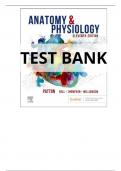, Anatomy and Physiology 11th Edition kkh kkh kkh kkh
PattonTest Bank kkh k
h kkh
Chapter 01: Organization of the Body
kkh kkh kkh kkh kkh
Patton: Anatomy and Physiology, 11th Edition
kkh kkh kkh kkh kkh
MULTIPLE CHOICE kkh
1. Which of the following describes anatomy?
kkh kkh kkh kkh kkh
a. Using devices to investigate parameters such as heart rate and blood pressure
kkh kkh kkh kkh kkh kkh kkh kkh kkh kkh kkh
b. Investigating human structure via dissections and other methods
kkh kkh kkh kkh kkh kkh kkh
c. Studying the unusual manner in which an organism responds to painful stimuli
kkh kkh kkh kkh kkh kkh kkh kkh kkh kkh kkh
d. Examining the physiology of life kkh kkh kkh kkh
ANS: B DIF: Memorization
k k h REF: p. kkh
3TOP: Anatomy and Physiology
kkh h
k kkh kkh kkh
2. Systemic anatomy is a term that refers to:
kkh kkh kkh kkh kkh kkh kkh
a. physiological investigation at a microscopic level. kkh kkh kkh kkh kkh
b. anatomical investigation that begins in the head and neck and concludes at the
kkh kkh kkh kkh kkh kkh kkh kkh kkh kkh kkh kkh
feet. kkh
c. anatomical investigation that uses an approach of studying the
kkh kkh kkh kkh kkh kkh kkh kkh
body bysystems—groups of organs having a common function.
kkh kkh kh kkh kkh kkh kkh kkh kkh
d. anatomical investigation at the molecular level. kkh kkh kkh kkh kkh
ANS: C DIF: Memorization
k k h REF: p. kkh
4TOP: Anatomy and Physiology
kkh h
k kkh kkh kkh
3. Physiology can be subdivided according to the
kkh kkh kkh kkh kkh kkh studied.
a. type of organism kkh kkh
b. organizational level kkh
c. systemic function kkh
, d. All of the above are correct.
kkh kkh kkh kkh kkh
ANS: k k h D DIF: Memorization REF: p. kkh
4TOP:
kkh h
k k k h Physiology
4. Physiology:
a. recognizes the unchanging (as opposed to the dynamic) nature of things.
kkh kkh kkh kkh kkh kkh kkh kkh kkh kkh
b. investigates the body’s structure. kkh kkh kkh
c. is concerned with organisms and does not deal with different levels
kkh kkh kkh kkh kkh kkh kkh kkh kkh kkh
oforganizationsuch as cells and systems.
kkh kh kkh kkh kkh kkh
d. is the science that examines the function of living organisms and their parts.
kkh kkh kkh kkh kkh kkh kkh kkh kkh kkh kkh kkh
ANS: k k h D DIF: Memorization REF: p. kkh
4TOP:
kkh h
k k k h Physiology
5. One of the basic principles of the standardized terminology is the avoidance of
kkh kkh kkh kkh kkh kkh kkh kkh kkh kkh kkh kkh
,
orterms that are based on a person’s name.
kkh h
k kkh kkh kkh kkh kkh kkh kkh
a. homonyms
b. antonyms
c. eponyms
d. synonyms
ANS: k k h C DIF: Memorization REF: p. 5 kkh kkh
TOP: Language of Science and Medicine
kkh kkh kkh kkh kkh
6. Metabolism refers to: kkh kkh
a. the chemical basis of life.
kkh kkh kkh kkh
b. the sum of all the physical and chemical reactions occurring in the body.
kkh kkh kkh kkh kkh kkh kkh kkh kkh kkh kkh kkh
c. an organization of similar cells specialized to perform a certainfunction.
kkh kkh kkh kkh kkh kkh kkh kkh kkh
d. a subdivision of physiology.
kkh kkh kkh
ANS: k k h B DIF: Application REF: kkh kkh kkh p. 5 kkh TOP: Characteristics of Life
kkh kkh kkh
7. From smallest to largest, the levels of organization of the body are:
kkh kkh kkh kkh kkh kkh kkh kkh kkh kkh kkh
a. organism, chemical, tissue, cellular, organ, system, organelle.
kkh kkh kkh kkh kkh kkh
b. chemical, microscopic, cellular, tissue, organ, system, organism.
kkh kkh kkh kkh kkh kkh
c. organism, system, organ, tissue, cellular, organelle, chemical.
kkh kkh kkh kkh kkh kkh
d. chemical, organelle, cellular, tissue, organ, system, organism.
kkh kkh kkh kkh kkh kkh
ANS: D DIF: Memorization
k k h REF: p. kkh
6TOP: Levels of Organization
kkh h
k kkh kkh kkh
8. The smallest living units of structure and function in the body are:
kkh kkh kkh kkh kkh kkh kkh kkh kkh kkh kkh
a. molecules.
b. cells.
c. organelles.
d. atoms.
ANS: B DIF: Memorization
k k h REF: p. kkh
7TOP: Levels of Organization
kkh h
k kkh kkh kkh
9. An organization of many simN
kkh arRcS
ilU elI thG
ls N atTaB
re.sC ciM
peO alized to perform a certain
kkh kkh kkh kkh kkh kkh kkh
function is called a(n):
kkh kkh kkh kkh
a. tissue.
b. organism.
c. system.
, d. organ.




